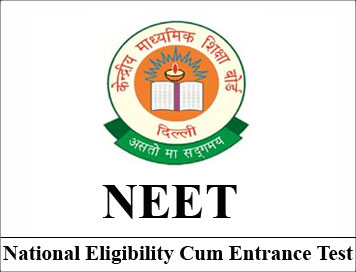(Syllabus) CBSE: National Eligibility Cum Entrance Test (NEET) "Physics"
Disclaimer: This website is NOT associated with CBSE, for official website of CBSE visit - www.cbse.gov.in

(Syllabus) CBSE: National Eligibility Cum Entrance Test (NEET) "Physics"
The Medical Council of India (MCI) recommended the following syllabus for National Eligibility-cum-Entrance Test for admission to MBBS/BDS courses across the country (NEET-UG) after review of various State syllabi as well as those prepared by CBSE, NCERT and COBSE. This is to establish a uniformity across the country keeping in view the relevance of different areas in Medical Education.

CONTENTS CLASS XI SYLLABUS
UNIT I: Physical World and Measurement
- Physics: Scope and excitement; nature of physical laws; Physics, technology and society.
- Need for measurement: Units of measurement; systems of units; SI units, fundamental and derived units. Length, mass and time measurements; accuracy and precision of measuring instruments; errors in measurement; significant figures.
- Dimensions of physical quantities, dimensional analysis and its applications.
UNIT II: Kinematics
-
Frame of reference, Motion in a straight line; Position-time graph, speed and velocity. Uniform and non-uniform motion, average speed and instantaneous velocity. Uniformly accelerated motion, velocity-time and position-time graphs, for uniformly accelerated motion (graphical treatment).
-
Elementary concepts of differentiation and integration for describing motion. Scalar and vector quantities: Position and displacement vectors, general vectors, general vectors and notation, equality of vectors, multiplication of vectors by a real number; addition and subtraction of vectors. Relative velocity.
-
Unit vectors. Resolution of a vector in a plane-rectangular components.
-
Scalar and Vector products of Vectors. Motion in a plane. Cases of uniform velocity and uniform acceleration- projectile motion. Uniform circular motion.
UNIT III: Laws of Motion
- Intuitive concept of force. Inertia, Newton’s first law of motion; momentum and Newton’s second law of motion; impulse; Newton’s third law of motion. Law of conservation of linear momentum and its applications.
- Equilibrium of concurrent forces. Static and Kinetic friction, laws of friction, rolling friction, lubrication.
- Dynamics of uniform circular motion. Centripetal force, examples of circular motion (vehicle on level circular road, vehicle on banked road).
UNIT IV: Work, Energy and Power
- Work done by a constant force and variable force; kinetic energy, work-energy theorem, power.
- Notion of potential energy, potential energy of a spring, conservative forces; conservation of mechanical energy (kinetic and potential energies); non-conservative forces; motion in a vertical circle, elastic and inelastic collisions in one and two dimensions.
UNIT V: Motion of System of Particles and Rigid Body
- Centre of mass of a two-particle system, momentum conservation and centre of mass motion. Centre of mass of a rigid body; centre of mass of uniform rod.
- Moment of a force,-torque, angular momentum, conservation of angular momentum with some examples.
- Equilibrium of rigid bodies, rigid body rotation and equation of rotational motion, comparison of linear and rotational motions; moment of inertia, radius of gyration. Values of M.I. for simple geometrical objects (no derivation). Statement of parallel and perpendicular axes theorems and their applications.
Click Here for Full Syllabus
<< Go Back to Main Page
Courtesy: CBSE